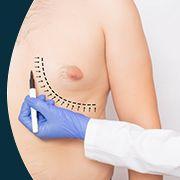Minimally Invasive Lipoma Surgery: Procedures and Benefits
In This Article
Minimally Invasive Lipoma Surgery: Procedures and Benefits
Ashitha Kareem
Updated on May 21, 2024
Medically verified by Dr. Arya
Fact checked by Dr. Pournami

Cosmetic
6 min read
Looking for the top doctors? Want to know more about how lipoma removal works?
We get how tricky this decision can be.
We’re here to give you all the info you need, making your choice easier and more informed.
Mykare Health also assists in locating the best hospitals and top doctors. We ensure you receive the highest quality care for your needs.
Your health and comfort matter most to us.
What is Lipoma
The American Cancer Society characterizes lipomas as benign tumors composed of adipose tissue.
They are soft, non-cancerous lumps that grow underneath the skin. They're made of fat and usually appear predominantly in adults.
These lumps usually grow slowly and are often found between the skin and the muscle layer beneath. They typically occur on the neck, torso, arms, and legs.
Although it's rare, some people can have multiple lipomas, a condition that can run in families.
Generally, lipomas are harmless and don't need treatment. However, if a lipoma becomes bothersome, painful, or keeps growing, you might decide to have it taken out.
What causes Lipomas
The exact cause of lipomas isn't known, but they might be linked to genetics since they often run in families. Certain conditions can also lead to the development of multiple lipomas, including:
- Dercum’s disease, which brings painful lipomas mainly on arms, legs, and trunk.
- Gardner syndrome, which leads to lipomas along with other health issues.
- Hereditary multiple lipomatosis, a genetic condition causing multiple lipomas.
- Madelung’s disease is often found in men who consume a lot of alcohol. They are likely to get lipomas around the neck and shoulders.
Minimally Invasive Surgical Procedures
Minimally invasive surgery is replacing the traditional open surgical approach for many abdominal procedures.
Some of the minimally invasive surgical methods are given below
1.Remote Incision Liposuction Removal
Remote Incision Liposuction removal is a great option for removing lipomas that are 4 cm or larger. It can also be used when there are many lipomas.
Demand for smaller and cosmetically acceptable scars are increasing.
By this method incisions placed in aesthetically better sites than directly over the lesion.
Here's how it works:
- A small incision is made and a tube is inserted
- Lipoma’s Fat globules are broken down with the tool
- These fat contents are then sucked out through the cannula by a vacuum.
- This method has few minor after-effects that don't last long.
Benefits:
- Reduces surgery time.
- Smaller scar.
- Better shape after healing.
- Can remove many lipomas with one cut.
- Low chance of lipomas coming back.
- Very small chance of turning into cancer.
2. Focused ultrasound
Focused ultrasound is a noninvasive, therapeutic technology.It is considered a Minimally Invasive Surgery. Compared to the traditional medical treatments it decreases the cost of care for patients with lipomas that need to be removed.
Here's how it works:
- Focuses ultrasound beams precisely on the lipoma.
- The beams converge and destroy the targeted tissue.
- Allows for non-surgical removal of lipomas.
Benefits:
- Noninvasive alternative to surgery.
- Less risk of complications like infection.
- Lower cost compared to traditional surgery.
- Targets lipomas without harming surrounding tissue.
- Repeatable if necessary.
3.Endoscope-assisted Lipoma Removal
Endoscopic lipoma removal is a surgical method that uses an endoscope to cut out lipomas. Endoscopic resection with endoloop-assisted unroofing technique is safe and effective for giant lipomas
Here's how it works:
- A surgeon makes one or more incision near the lipoma
- A small tube with light and camera at the end is gently inserted through the incision
- Video and images can be seen in the monitor with the help of the cameras and light at the end of the endoscopic tool
- Additional surgical tools are inserted
- With the guidance of the images the surgeon carefully cut and removed the lipoma.
- The incisions are sealed or sutured
Benefits:
- Less scarring, quick recovery.
- Lower pain, fewer complications.
- Often same-day discharge.
4. Endoloop ligation lipoma removal
Endoloop ligation is an advanced use of endoscopy. Treating big colonic lipomas with it offers a new way for patients who might need surgery. This method tries to cut down the risk of holes that can happen with snare cautery.
Here's how it works:
- The endoscopic tools are used to identify the lipoma
- Once lipoma is visualized the surgeon identifies base or stalk of lipoma
- Endoloop is carefully placed around the base of lipoma.
- The pre-tied surgical suture is tightened around the base to restrict blood supply.
- The lipoma is detached and removed through any of the incisions.
Benefits:
- Controlled bleeding and clean removal
- Precise and less damage to surrounding areas
- Faster recovery
Suction assisted and minimal incision removal are also done by surgeons for lipoma removal.
Combining liposuction with surgical excision offers a dependable method for lipoma removal.
The risk of them becoming malignant or recurring is low. Performing liposuction through a small incision typically yields favorable cosmetic outcomes.
Once the lipoma is reduced in size, any remaining fatty and capsular tissues can be extracted without the need to extend the incision.
 9 min read
9 min readThe Advantages of Choosing Mykare Health for Gynecomastia Surgery
 6 min read
6 min readIdentifying The Ideal Age For Gynecomastia Surgery
 6 min read
6 min readPre and Post Gynecomastia Surgery: Essential Things to Know
Get a Callback Now
Benefits of Minimally Invasive Surgery against Traditional Open Surgery
| | Traditional Open Surgery* | *Minimally Invasive Surgery|
| ------------ | -----------|--------|
| Incisions /Cut or scars| Large |Small |
| Physical Trauma/ Postoperative pain & Risk of Infection | High | Low |
| Recovery Period | Large | Small |
Advantages of Minimally Invasive Surgery
- Reduced Trauma
- Reduced blood loss
- Higher accuracy and precision
- Reduced hospital stay
- Reduced complications in longer time
Disadvantages of Minimally Invasive Surgery
- It can be expensive
- It may not be available in local hospitals
Recovery
Minimally invasive surgery often means a shorter recovery and fewer post-op limits. Patients usually get back to their daily lives quicker than with traditional surgery, with less chance of issues.
Restrictions after Minimally Invasive Surgery
Even though the complications of Minimally Invasive Surgery are considered very less, it is important to understand your body needs time to heal.
Without doctors consultation and approval for a period of 2 to 4 weeks heavy physical activity is strictly restricted. The restrictions include: BOX
- No strenuous activity, like cycling, jogging, lifting etc..
- No driving
- Prolonged periods of traveling etc.
Recovery will vary from patient to patient. It is important to strictly follow docto
r's instructions during the recovery period.
Always do consult a doctor incase of:
- Signs of infection
- Persistent pain or worsening over time
- Unexpected bleeding
- Swelling or lump formation
- Or any sort of question or concerns.
Minimally Invasive Surgery offers lesser pain and quicker recovery compared to traditional open surgery for lipoma removal
Practicing techniques include remote incision liposuction, endoscope-assisted removals, minimizing scarring etc.
Advantages encompass shorter hospital stays, reduced incisions, and a lower risk of recurrence and infection.
Challenges include higher costs and limited availability in local hospitals.
Post surgery patients are to avoid heavy physical activities in 2 to 4 weeks and doctors advise.
It’s important for patients to consult their doctor if they experience signs of infection, persistent pain, or unexpected bleeding post-surgery.
Source Links
Cleveland Clinic
Thieme connect
National Library of Medicine
National Library of Medicine
Focused Ultrasound Foundation
National Library of Medicine
Plastic Surgery International



